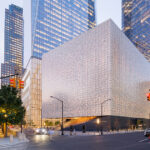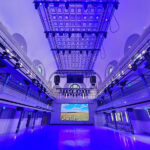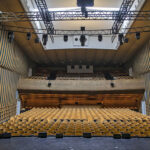Upping the Ante from 9,000 to 10,000 Seats
When you first think Vegas, you probably don’t think about Red Rock. That belongs in Colorado, right? Well, yes. But there’s also the beautiful Red Rock National Conservation Area in the peaks outside of Las Vegas. And the Red Rock Casino Resort just down the road has their own outdoor amphitheatre that competes with the best venues in town, thanks to the stage and seating from Brown United.Red Rock Casino started hosting outdoor shows with staging and seating from Brown United in 2007 when they booked Kanye West and again in 2009 with Toby Keith. Those shows had only two sets of bleachers and a modest stage set up on the south side of the outdoor area, but it was obvious the casino was on to something big.
“With the success of those shows, the owners decided to make the amphitheatre more permanent and use it every season,” says Judy Alberti, VP of entertainment for Station Casinos, the company that owns Red Rock Casino. In 2011, they moved the stage to the west side of the outside area and added a third section of bleachers to form a U-shaped audience section.
Now they could seat 9,000 attendees—and they did. They found that attendance was high enough that they could have sold even more tickets. Red Rock decided they wanted their amphitheatre to do the big shows and compete with the Arena at Mandalay Bay and the MGM Grand, so they needed to be in the capacity range of those venues, and 9,000 seats wasn’t enough.
“It’s a constantly evolving target, a kind of a supply and demand issue,” says Alberti.
They decided to upgrade their capacity after the 2011 season and take their capacity up to 10,000. It was an easy decision to stick with Brown United.
“Their reputation in the industry for safety and construction and customer service is second to none,” says Alberti. They also made sense in terms of the budget. “We did bid to other companies, but Brown United definitely made sense economically.”
John Brown credits his large inventory as the reason he’s able to keep costs down. “We have a large inventory of rental stock, so we don’t have to manufacture anything when a job comes in,” says Brown. “Which makes us more cost-effective.”
Tetris with Seats
Once they’d decided on a size, it was time to engineer the new configuration. Their biggest challenge was to utilize the space efficiently. With a 60-by-44-foot stage and 10,000 seats, it was a challenge to make it all fit into the outdoor footprint just outside the casino. To make it all work, they had to move the stands 10 to 15 feet east, further from the stage. Also, the concourses underneath the stands needed large-enough pedestrian walkways for entry and exit.
“It’s kind of like playing Tetris,” laughs Kevin Scroggins, director of production for entertainment at Red Rock. Brown and his team worked with Red Rock’s architect to design the amphitheatre, and they were pleased with his comprehensive knowledge of local codes, state laws and even international building code. “Because the architectural firm knew so much about the bleacher business, that made it very easy to convert their initial architectural drawings into structural drawings,” says Brown.
Brown and his team also called in a secondary engineer to make sure the new structures would be up to Nevada codes. That engineer brought in their own independent review of the calculations. “We wanted to make sure we dotted our I’s and crossed our T’s on any issue that may have surfaced,” says Brown. “Every single scaffold, bleacher, seat, staging or roof element had a structural review on it. We don’t build anything without a structural review, a wet stamp and a sign off from an outside engineer. We’ve always done that.”
The engineers had lots of double-checks, but one of the things they knew from the start was that the entire seating section would have to make that 10-to-15-foot shift from the stage, which meant they wouldn’t just be able to add the mitre sections in to fill out the seating section. “We knew from Day One we’d have to disassemble everything,” says Scroggins. Brown and Scroggins immediately came up with a schedule, allowing two months to tear down all the seats, move them, reassemble the seating structure (with the new corner sections added), bolster the stands for the concourses underneath, and then wrap the whole structure in a vinyl fabric.
They did it, and the first show started right on time.
Semi-Permanent Bleachers
The bleachers are a particular point of pride for Brown, who spent the time to make sure that the seats were permanent in all but name, and built the structure with such amenities as wider concourses to house restrooms and concessions underneath them.
“There’s more steel in this bleacher structure than we’ve ever built before, because of the concourses,” says Brown. “We had to span great distances under the seats to create a wider walkway underneath.”
To protect everyone walking around under the seats, they put in spill-proof softgoods and other infrastructure to ensure that nothing dropped or dripped from the seats would fall on to people below.
To make it appear as if the bleachers were one solid, permanent structure, they wrapped the whole structure with a 90 percent polypropylene fabric to enclose it. A vinyl wall is 100 percent polypropylene, and the industry standard for these types of wraps is a fabric that’s approximately 70 percent polypropylene. The extra thickness and heft to the fabric means it presents exceptionally well to people driving by or even walking next to it.
Sticking with the Steel Stage
The stage didn’t change much from last year, but that says more about the capacity of the stage that any inhibition to go larger. When Brown United and the team at Red Rock designed the stage, they looked at what most bands asked for on their riders and built for that. They settled on a stage that was 60 feet wide and 44 feet deep, with two stage rings, left and right, approximately 16 feet by 24 feet, that will fit all but the most enormous of acts.
But just because it didn’t get changed doesn’t mean Brown hasn’t been watching it. In addition to the inspections and maintenance the venue performs on the stage and roof, Brown United sends reps to perform monthly maintenance checks. They also have a rep onsite for every show.
The roofing structure over the stage also stayed in—and a good thing, too, because when they installed it they put it into concrete foundations. It’s built of steel—not aluminum—and was designed to withstand gusts of wind closing in on 90 miles per hour. Because Red Rock needed to be able to host multiple types of events in the amphitheatre, they wanted a roof that could handle anything. The roof can support approximately 100,000 pounds.
“We can rig pretty much anything that comes in,” says Scroggins.
Still, Brown doesn’t leave anything to chance. His company takes the light, sound and video plots for each show and sends them through engineering for structural review and approval. Every plot gets looked at individually. “There is no standard plan for us,” says Brown. They also send a certified rigger to work with the band’s production on every show, discuss operational plans with the casino, identify all parties responsible for engineering and staging choices on the band’s team, and make sure there are emergency plans in place. Then, during shows, they make sure that the roof structure is used in accordance with the engineer’s operating plan.
Safety
If all of this sounds like Brown takes safety seriously, it’s meant to. He’s well aware of the recent catastrophies around semi-permanent staging—but even before the tragic events of the past year, he had devoted himself to making safety his number one priority. At Red Rock Casino they retain a meteorologist who is on site before and during events to keep track of wind and weather in the area and forecast an accurate picture for the facility using Doppler radar. “We’ll know if there are windy conditions coming hours ahead of time so there’s not an issue of lowering screens or rigging in foul weather—that gets done way ahead of time,” says Brown.
Red Rock Casino also takes the safety of their guests and workers seriously. “We’ve canceled shows before. We’ve always had an eye to the utmost safety,” says Albierti.
“Once again, that’s why we like using John Brown,” adds Scroggins. “Their whole roof system is made out of steel, not aluminum. It can withstand wind factors, and weight loads so much more than these other roof systems, which is why we prefer going with Brown United, especially with the larger acts who bring in more gear.”
Stunning in the Sun
This summer, Red Rock Casino is reaping the rewards of installing the new seating. Acts like the Beach Boys, Toby Keith, Poison and Def Leppard are rolling through, and audiences are taking advantage of the new space, too. Brown is understandably a little proud of the venue. “I truly believe it’s one of the nicest temporary amphitheatres in the country,” he says. “The quality and strength of the material and the versatility of the site goes above and beyond the industry standard. Most people choose to stick with rental stock that just gets used over and over again and beat up. This stadium was built in such a way that you feel like it’s going to be there forever.”
And the folks at Red Rock couldn’t be happier either. “We took a little bit of everything, what people prefer, what else is in Vegas, and made this amphitheatre the best,” says Scroggins.


